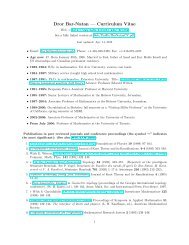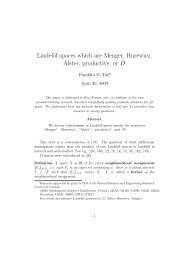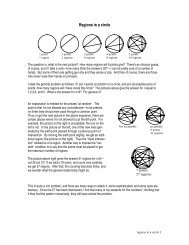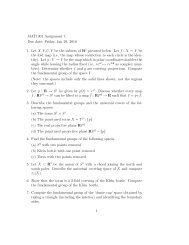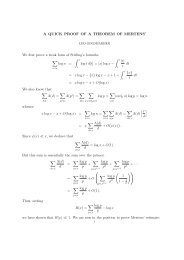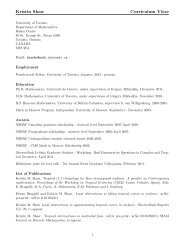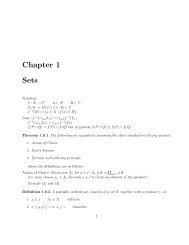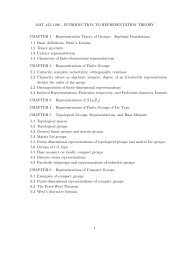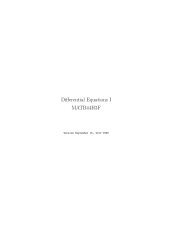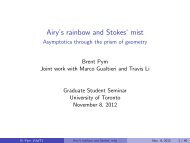Regions in a circle
Regions in a circle
Regions in a circle
You also want an ePaper? Increase the reach of your titles
YUMPU automatically turns print PDFs into web optimized ePapers that Google loves.
1 po<strong>in</strong>t<br />
1 region<br />
2 po<strong>in</strong>ts<br />
2 regions<br />
<strong>Regions</strong> <strong>in</strong> a <strong>circle</strong><br />
3 po<strong>in</strong>ts<br />
4 regions<br />
The question is, what is the next picture? How many regions will 6 po<strong>in</strong>ts give? There's an obvious guess,<br />
of course, and if I take a vote––how many th<strong>in</strong>k the answer's 32?––I can be pretty sure of a number of<br />
hands. But some of them are gett<strong>in</strong>g gun-shy and they sense a trap. And then of course, there are those<br />
who never raise their hands on pr<strong>in</strong>ciple.<br />
I state the general problem as follows: if I put n po<strong>in</strong>ts at random on a <strong>circle</strong>, and jo<strong>in</strong> all possible pairs of<br />
po<strong>in</strong>ts, how many regions will I have <strong>in</strong>side the <strong>circle</strong>? The pictures above give the answer for n equal to<br />
1,2,3,4, and 5. What is the answer for n=6? For general n?<br />
An explanation is needed for the phrase "at random". The<br />
po<strong>in</strong>t is that I'm not allowed any co<strong>in</strong>cidences––to be precise,<br />
no three l<strong>in</strong>es should ever pass through a common po<strong>in</strong>t.<br />
Thus, to get the next picture <strong>in</strong> the above sequence, there are<br />
certa<strong>in</strong> places where I'm not allowed to put the 6th po<strong>in</strong>t. For<br />
example, the picture on the right is acceptable, the one on the<br />
left is not. In the picture on the left, one of the new l<strong>in</strong>es generated<br />
by the sixth po<strong>in</strong>t passed through a previous po<strong>in</strong>t of<br />
<strong>in</strong>tersection. By mov<strong>in</strong>g the sixth po<strong>in</strong>t slightly, we get an additional<br />
region (the picture on the right). Thus the "triple <strong>in</strong>tersection"<br />
robbed us of a region. Another way to impose the "random"<br />
condition is to say that the po<strong>in</strong>ts must be placed to get<br />
the maximum number of regions.<br />
The picture above right gives the answer 31 regions for n=6—<br />
not 32 but 31! If we add a 7th po<strong>in</strong>t, and count very carefully,<br />
we get 57 regions. After that, the count<strong>in</strong>g becomes tricky, and<br />
we wonder what the general relationship might be.<br />
4 po<strong>in</strong>ts<br />
8 regions<br />
5 po<strong>in</strong>ts<br />
16 regions<br />
Not acceptable<br />
7 po<strong>in</strong>ts<br />
57 regions<br />
acceptable<br />
6 po<strong>in</strong>ts<br />
31 regions<br />
This is quite a rich problem, and there are many ways to attack it, some sophisticated, and some quite elementary.<br />
Once the 57 has been discovered, I f<strong>in</strong>d that many of my students hit “the numbers”, th<strong>in</strong>k<strong>in</strong>g that<br />
if they f<strong>in</strong>d the pattern numerically, they will have solved the problem.<br />
regions <strong>in</strong> a <strong>circle</strong> 1
The first th<strong>in</strong>g they do is a fast “successive differences” on the<br />
R-values and they get the table at the right. The last column is<br />
certa<strong>in</strong>ly compell<strong>in</strong>g. What if that pattern cont<strong>in</strong>ues? What if<br />
the next entry <strong>in</strong> that column is a 5? I leave it to you to show<br />
that the next R-value would then be R(8)=99. Could this be<br />
correct? What sort of argument would we need to establish<br />
that? Perhaps we might try to relate the numbers <strong>in</strong> the difference<br />
table to the geometry of the l<strong>in</strong>es and regions, so that we<br />
could “see” the pattern <strong>in</strong> the table not just numerically, but<br />
geometrically.<br />
Okay. We are <strong>in</strong>terested <strong>in</strong> “differences” <strong>in</strong> successive R values,<br />
so let’s ask what happens to R when we add a new po<strong>in</strong>t.<br />
How many new regions do we get?<br />
Well, each new po<strong>in</strong>t necessitates the draw<strong>in</strong>g of a number of<br />
new l<strong>in</strong>es, and each of these new l<strong>in</strong>es will create a number of<br />
new regions. But how many?<br />
The key observation (which was also the idea beh<strong>in</strong>d our<br />
analysis of the cutt<strong>in</strong>g planes problem) is that this new l<strong>in</strong>e<br />
creates new regions by slic<strong>in</strong>g through old regions and cutt<strong>in</strong>g<br />
them <strong>in</strong> two, and the number of new regions created is the<br />
number of old regions this l<strong>in</strong>e slices! And a nice way to th<strong>in</strong>k<br />
about that, is to notice that each time the l<strong>in</strong>e <strong>in</strong>tersects an<br />
exist<strong>in</strong>g l<strong>in</strong>e, it leaves one old region and enters another, so the<br />
number of old regions it encounters is one more than the number<br />
of old l<strong>in</strong>es it meets.<br />
We need some notation. We are focus<strong>in</strong>g on l<strong>in</strong>es and <strong>in</strong>tersections<br />
of l<strong>in</strong>es, so let's keep track of the number of each at<br />
each stage. Let L denote the total number of l<strong>in</strong>es, I the number<br />
of <strong>in</strong>tersections of l<strong>in</strong>es (<strong>in</strong>side the <strong>circle</strong>) and R as before<br />
the number of regions. If we tabulate these quantities for the<br />
first seven pictures, we get the table at the right.<br />
I ask the class to f<strong>in</strong>d patterns <strong>in</strong> the table, and immediately we<br />
get the observation that:<br />
R = 1 + L + I.<br />
Hmm. This is nice, because if it's true, then we can obta<strong>in</strong> the<br />
R-column by figur<strong>in</strong>g out the (possibly simpler) L-column and Icolumn.<br />
But why should the above equation hold? Aga<strong>in</strong> we have a<br />
numerical observation that we would like to verify with a geometric<br />
argument.<br />
n R<br />
1 1<br />
2 2<br />
1<br />
1<br />
2 1<br />
3 4 2<br />
4 2<br />
4 8 4<br />
8 3<br />
5 16 7<br />
15 4<br />
6 31 11<br />
26<br />
7 57<br />
The last column of the table is<br />
certa<strong>in</strong>ly nice. But one of the<br />
students notes that we’ve seen<br />
the third column before—the<br />
sequence 1, 2, 4, 8, 15, 26 gives<br />
the number of regions when 3space<br />
is cut by 0, 1, 2, 3 etc.<br />
planes <strong>in</strong> general position! Holy<br />
cow! [See problem 3]<br />
n L I R<br />
1 0 0 1<br />
2 1 0 2<br />
3 3 0 4<br />
4 6 1 8<br />
5 10 5 16<br />
6 15 15 31<br />
7 21 35 57<br />
regions <strong>in</strong> a <strong>circle</strong> 2
Well, the above argument for the creation of new regions provides<br />
an <strong>in</strong>ductive type of proof! Indeed, what happens when<br />
we draw a new l<strong>in</strong>e? Well, R and I both <strong>in</strong>crease, and what we<br />
argued above was that the <strong>in</strong>crease <strong>in</strong> R will be one more than<br />
the <strong>in</strong>crease <strong>in</strong> I. Now s<strong>in</strong>ce L also <strong>in</strong>creases by 1, if the formula<br />
held before the draw<strong>in</strong>g of the new l<strong>in</strong>e, it must still hold<br />
afterwards. To emphasize this, if the new l<strong>in</strong>e meets 12 old<br />
l<strong>in</strong>es, then I will have <strong>in</strong>creased by 12, L will have <strong>in</strong>creased by<br />
1, and R will have <strong>in</strong>creased by 13––and the equation will rema<strong>in</strong><br />
balanced. Formally, what we have here is a proof by<br />
<strong>in</strong>duction on n, the number of po<strong>in</strong>ts. First we note that the<br />
formula holds for n=1 (<strong>in</strong> that case, R=1, I=0 and L=0). Then<br />
note that to move from any n to n+1 we add a number of l<strong>in</strong>es,<br />
and the above argument shows that the formula cont<strong>in</strong>ues to<br />
hold with the addition of each new l<strong>in</strong>e.<br />
Hav<strong>in</strong>g perceived and established this formula, our attention<br />
now shifts from R to L and I (which ought to be simpler), and<br />
we now try to get hold of them.<br />
The L-column is simple enough. The students note quite<br />
quickly that the successive differences <strong>in</strong> the L-column are<br />
1,2,3,4, etc. Of course, it is clear why this holds: consider the<br />
addition of the 6th po<strong>in</strong>t. This will necessitate the draw<strong>in</strong>g of 5<br />
new l<strong>in</strong>es (to each exist<strong>in</strong>g po<strong>in</strong>t). So L must <strong>in</strong>crease by 5. In<br />
general, the addition of the nth po<strong>in</strong>t will <strong>in</strong>crease L by n–1. By<br />
add<strong>in</strong>g up the differences, we even get a formula for L <strong>in</strong> terms<br />
of n:<br />
( n −1)<br />
n<br />
L()<br />
n = 1+<br />
2 + 3 + ... + ( n −1)<br />
= .<br />
2<br />
The expression on the right comes from a standard formula for<br />
the sum of the first n natural numbers. See problem 2.<br />
The I-pattern is a bit more <strong>in</strong>terest<strong>in</strong>g, and I put the class <strong>in</strong>to<br />
small group discussion mode for a time. A number of arguments<br />
emerge. A popular approach is to do successive differences<br />
aga<strong>in</strong> and we get a similar pattern to what happened<br />
when we tried this with R. But this time one of the groups<br />
gives me an “anatomy” of the first-difference column:<br />
0,0,1,4,10,20.<br />
n L I R<br />
1 0 0 1<br />
2 1 0 2<br />
3 3 0 4<br />
4 6 1 8<br />
5 10 5 16<br />
6 15 15 31<br />
7 21 35 57<br />
n I<br />
1 0<br />
0<br />
2 0<br />
0<br />
0<br />
1<br />
3 0 1<br />
1 2<br />
4 1<br />
4<br />
3<br />
3<br />
5 5 6<br />
10 4<br />
6 15 10<br />
20<br />
7 35<br />
regions <strong>in</strong> a <strong>circle</strong> 3
Consider the 20. That represents the number of <strong>in</strong>tersections<br />
created by the addition of the 7th po<strong>in</strong>t. Now these <strong>in</strong>tersections<br />
come from jo<strong>in</strong><strong>in</strong>g the 7th po<strong>in</strong>t to the exist<strong>in</strong>g po<strong>in</strong>ts. For<br />
example, consider the effect of jo<strong>in</strong><strong>in</strong>g the 7th po<strong>in</strong>t to the 3rd po<strong>in</strong>t. That new l<strong>in</strong>e will <strong>in</strong>tersect all the l<strong>in</strong>es that connect<br />
po<strong>in</strong>ts on one side of the l<strong>in</strong>e to po<strong>in</strong>ts on the other. Now there<br />
are 2 po<strong>in</strong>ts on one side and 3 po<strong>in</strong>ts on the other for a total of<br />
2×3=6 possible l<strong>in</strong>es and therefore 2×3=6 new <strong>in</strong>tersections.<br />
Similarly, the effect of jo<strong>in</strong><strong>in</strong>g the 7th po<strong>in</strong>t to the 2nd po<strong>in</strong>t will<br />
be to create a total of 1×4=4 new <strong>in</strong>tersections. The total<br />
number of new <strong>in</strong>tersections due to the addition of the 7th po<strong>in</strong>t<br />
is:<br />
0×5 + 1×4 + 2×3 + 3×2 + 4×1 + 5×0 = 20<br />
and that’s an “anatomy” of the 20. We can of course omit the<br />
first and the last terms which will always give 0.<br />
We get a similar anatomy of the other entries <strong>in</strong> the column.<br />
For example the 10 is:<br />
1×3 + 2×2 + 3×1 = 10.<br />
This analysis makes it easy to generate the I column entry-byentry<br />
and if we put this together with our L-formula, this gives<br />
us a simple numerical algorithm for generat<strong>in</strong>g successive values<br />
of R.<br />
For example, to get the value of R(8) we calculate:<br />
( n −1)<br />
n 7×<br />
8<br />
L () 8 = = = 28<br />
2 2<br />
I(8) = I(7) + (1×5 + 2×4 + 3×3 + 4×2 + 5×1) = 35 + 35 = 70<br />
R(8) = 1 + L(8) + I(8) = 1 + 28 + 70 = 99.<br />
This method is a great advance on count<strong>in</strong>g regions on a picture,<br />
and we should be proud of ourselves!<br />
Of course, this is no way to get the R value for n=100 (except<br />
with a computer). The po<strong>in</strong>t is that, while we have a general<br />
formula for L, we don't have one for I; all we have is a recursive<br />
arithmetical "mach<strong>in</strong>e". Can we <strong>in</strong> fact get a formula for I?<br />
The answer is yes, and the above difference scheme can be<br />
used to get it; the procedure is just a bit more complicated than<br />
the argument that worked for the L-formula. But I'm not go<strong>in</strong>g<br />
to follow that up right now either because there's someth<strong>in</strong>g<br />
else around––someth<strong>in</strong>g quite extraord<strong>in</strong>ary...<br />
3<br />
4<br />
2<br />
5<br />
1<br />
7<br />
6<br />
n L I R<br />
1 0 0 1<br />
2 1 0 2<br />
3 3 0 4<br />
4 6 1 8<br />
5 10 5 16<br />
6 15 15 31<br />
7 21 35 57<br />
8 28 70 99<br />
regions <strong>in</strong> a <strong>circle</strong> 4
Some years ago I was discuss<strong>in</strong>g this problem with a high<br />
school class, and one of the students was a Pascal triangle nut<br />
(someone who believes that everyth<strong>in</strong>g good <strong>in</strong> life is somehow<br />
hidden <strong>in</strong> Pascal's triangle). So while we were busy writ<strong>in</strong>g<br />
down bigger and bigger R tables, he was writ<strong>in</strong>g down Pascal's<br />
triangle. And what he saw there was quite astonish<strong>in</strong>g––the L<br />
column is the second diagonal and the I column is the fourth<br />
diagonal! NOTE: there’s an unexpected count<strong>in</strong>g convention<br />
here––we call the extreme left diagonal of all 1’s the “zeroth”<br />
diagonal. In fact, that zeroth diagonal could just represent the<br />
“1” which is the first term <strong>in</strong> the R formula.<br />
Isn't that someth<strong>in</strong>g? What on earth are we to make of it? The<br />
first th<strong>in</strong>g to say is that, if this pattern does <strong>in</strong>deed hold, it gives<br />
us a nice formula for R because of course we have a comb<strong>in</strong>atorial<br />
<strong>in</strong>terpretation of each of the entries <strong>in</strong> Pascal's triangle.<br />
Indeed, the kth entry (from the left) <strong>in</strong> the nth row (where the 1<br />
at the top is taken to be the 0th row) is the number of ways of<br />
choos<strong>in</strong>g k objects from n [see Pascal] which is written ⎟ ⎛n<br />
⎞<br />
⎜ .<br />
⎝k<br />
⎠<br />
For example, there are 15 ways of choos<strong>in</strong>g 3 objects from 6,<br />
⎛6<br />
⎞<br />
so that ⎜ = 15<br />
3 ⎟ . This gives us very elegant formulae for L, I<br />
⎝ ⎠<br />
and therefore R, and these are displayed at the right.<br />
Below, we use these formulae to get the next entries of our Rtable,<br />
for n=9:<br />
Of course, the question is, why should these comb<strong>in</strong>atorial<br />
formulae hold? They are so simple and elegant, one feels that<br />
there must be an <strong>in</strong>terpretation of L and I <strong>in</strong> terms of choos<strong>in</strong>g<br />
objects from sets, that makes these formulae clear. Can we<br />
f<strong>in</strong>d a comb<strong>in</strong>atorial <strong>in</strong>terpretation of L and I?<br />
Well L is not so hard: with n po<strong>in</strong>ts, you get one l<strong>in</strong>e for every<br />
pair of po<strong>in</strong>ts, so L is the number of ways of choos<strong>in</strong>g 2 th<strong>in</strong>gs<br />
from n. The argument for I is more subtle, but just as simple:<br />
notice that there is a 1-1 correspondence between <strong>in</strong>terior <strong>in</strong>tersections<br />
and sets of 4 po<strong>in</strong>ts on the <strong>circle</strong>. Every set of four<br />
po<strong>in</strong>ts on the <strong>circle</strong> determ<strong>in</strong>es exactly one <strong>in</strong>tersection, and<br />
every <strong>in</strong>tersection is accounted for <strong>in</strong> this way. So the total<br />
number of <strong>in</strong>tersection I is just the number of ways of choos<strong>in</strong>g<br />
4 th<strong>in</strong>gs from n. Wow.<br />
1<br />
1 1<br />
1 2 1<br />
1 3 3 1<br />
1 4 6 4 1<br />
1 5 10 10 5 1<br />
1 6 15 20 15 6 1<br />
1 7 21 35 35 21 7 1<br />
1 8 28 56 70 56 28 8 1<br />
⎛n<br />
⎞<br />
L = ⎜<br />
⎟<br />
⎝2<br />
⎠<br />
⎛n<br />
⎞<br />
I = ⎜<br />
⎟<br />
⎝ 4⎠<br />
⎛n<br />
⎞ ⎛n<br />
⎞ ⎛n<br />
⎞<br />
R = 1+<br />
L + I = ⎜<br />
⎟ + ⎜<br />
⎟ + ⎜<br />
⎟<br />
⎝ 0⎠<br />
⎝ 2⎠<br />
⎝ 4⎠<br />
⎛9⎞<br />
9⋅<br />
8<br />
L () 9 = ⎜ = = 36<br />
2 ⎟<br />
⎝ ⎠ 2⋅1<br />
⎛ 9⎞<br />
9⋅<br />
8⋅<br />
7⋅<br />
6<br />
I () 9 = ⎜<br />
= 126<br />
4 ⎟ =<br />
⎝ ⎠ 4⋅<br />
3⋅<br />
2⋅1<br />
⎛9<br />
⎞ ⎛9⎞<br />
⎛9<br />
⎞<br />
R<br />
() 9 = ⎜ + = 1+<br />
36 + 126 = 163<br />
0 ⎟ + ⎜<br />
2 ⎟<br />
⎜<br />
4 ⎟<br />
⎝ ⎠ ⎝ ⎠ ⎝ ⎠<br />
regions <strong>in</strong> a <strong>circle</strong> 5
Problems<br />
Look at the column of first differences of I: 0,0,1,4,10,20 (see<br />
table at the right). Identify this as a diagonal of Pascal’s triangle<br />
(given above), and thus write each of these numbers as a<br />
comb<strong>in</strong>atorial coefficient. For example, 20 gets identified as<br />
⎛5<br />
⎞<br />
⎜<br />
⎟ . Argue on geometric grounds that that’s exactly what it<br />
⎝3<br />
⎠<br />
should be.<br />
2. The formula for the sum of the numbers from 1 to n.<br />
Write out the numbers between 1 and 9. Argue on grounds of<br />
symmetry that their average should be 5. Then argue that their<br />
sum should be 9 times their average which is 45. Use this<br />
same idea to show that the sum of the numbers from 1 to n is<br />
given by the formula:<br />
n(<br />
n + 1)<br />
1+<br />
2 + 3 + ... + n =<br />
2<br />
3. Return to Cut plane. While we are <strong>in</strong> the "elegant formula" bus<strong>in</strong>ess, a number of students noticed the<br />
similarity between the above R numbers and some of the number we had generated previously look<strong>in</strong>g at<br />
the number of regions created by n planes. To be precise, the sequence 1, 2, 4, 8, 16, 31, 57, etc. turns out<br />
to give the number of regions of 4-space created by cutt<strong>in</strong>g it with 0, 1, 2, 3, 4, 5, and 6 hyperplanes, respectively<br />
(Cut plane Problem 4). That is, n po<strong>in</strong>ts <strong>in</strong> the above <strong>circle</strong> problem "corresponds" to n–1 hyperplanes<br />
<strong>in</strong> the 4-space cutt<strong>in</strong>g problem. That suggests that the above R-formula can also be used to give the<br />
⎛n+<br />
1⎞<br />
⎛n+<br />
1⎞<br />
⎛n+<br />
1⎞<br />
number of regions created by n hyperplanes <strong>in</strong> 4-space. It will be R =<br />
. We have to<br />
⎜ ⎟ + ⎜ ⎟ + ⎜ ⎟<br />
⎝ 0 ⎠ ⎝ 2 ⎠ ⎝ 4 ⎠<br />
use n+1 <strong>in</strong>stead of n because, for example, the R value for the case of 5 hyperplanes seems to correspond<br />
to the R-value for 6 po<strong>in</strong>ts on the <strong>circle</strong>. Actually, it would be nice to have a formula which had n <strong>in</strong> place of<br />
n+1, and <strong>in</strong> fact we can get that from the rule: n ⎛ + 1⎞<br />
⎛ n ⎞ n<br />
.<br />
⎜ ⎟ = ⎜ ⎟ +<br />
⎝ r ⎠ ⎝r<br />
− ⎠ r<br />
⎛<br />
⎜<br />
⎝<br />
⎞<br />
⎟<br />
1 ⎠<br />
This is <strong>in</strong> fact the "addition rule" which is used to generate Pascal's triangle. [See Pascal]. Us<strong>in</strong>g this (for<br />
r>0) we get a spectacular formula for the number of regions created by n hyperplanes <strong>in</strong> 4-space:<br />
Why stop there?<br />
n planes <strong>in</strong> 3-space: R<br />
n l<strong>in</strong>es <strong>in</strong> 2-space: R<br />
n po<strong>in</strong>ts <strong>in</strong> 1-space: R<br />
n n n n n<br />
R = ⎛<br />
⎜<br />
⎝<br />
⎞<br />
⎟ +<br />
⎠<br />
⎛<br />
⎜<br />
⎝<br />
⎞<br />
⎟ +<br />
⎠<br />
⎛<br />
⎜<br />
⎝<br />
⎞<br />
⎟ +<br />
⎠<br />
⎛<br />
⎜<br />
⎝<br />
⎞<br />
⎟ +<br />
⎠<br />
⎛<br />
⎜<br />
⎝<br />
⎞<br />
⎟<br />
0 1 2 3 4 ⎠<br />
.<br />
n n n n<br />
= ⎛<br />
⎜<br />
⎝<br />
⎞<br />
⎟ +<br />
⎠<br />
⎛<br />
⎜<br />
⎝<br />
⎞<br />
⎟ +<br />
⎠<br />
⎛<br />
⎜<br />
⎝<br />
⎞<br />
⎟ +<br />
⎠<br />
⎛<br />
⎜<br />
⎝<br />
⎞<br />
⎟<br />
0 1 2 3 ⎠<br />
n n n<br />
= ⎛<br />
⎜<br />
⎝<br />
⎞<br />
⎟ +<br />
⎠<br />
⎛<br />
⎜<br />
⎝<br />
⎞<br />
⎟ +<br />
⎠<br />
⎛<br />
⎜<br />
⎝<br />
⎞<br />
⎟<br />
0 1 2 ⎠<br />
n n<br />
= ⎛<br />
⎜<br />
⎝<br />
⎞<br />
⎟ +<br />
⎠<br />
⎛<br />
⎜<br />
⎝<br />
⎞<br />
⎟<br />
0 1 ⎠<br />
Another wow.<br />
Is there any geometric logic beh<strong>in</strong>d these decompositions?<br />
n I<br />
1 0<br />
0<br />
2 0 0<br />
0 1<br />
3 0 1<br />
1 2<br />
4 1 3<br />
4 3<br />
5 5 6<br />
10 4<br />
6 15 10<br />
20<br />
7 35<br />
regions <strong>in</strong> a <strong>circle</strong> 6



